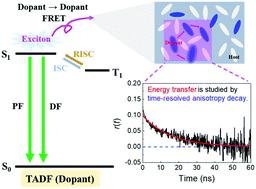当前位置:
X-MOL 学术
›
J. Mater. Chem. C
›
论文详情
Our official English website, www.x-mol.net, welcomes your
feedback! (Note: you will need to create a separate account there.)
Exciton energy transfer and bi-exciton annihilation in the emitting layers of thermally activated delayed fluorescence-based OLEDs
Journal of Materials Chemistry C ( IF 5.7 ) Pub Date : 2021-10-06 , DOI: 10.1039/d1tc03626b Hyunchul Kang 1 , Han Jin Ahn 2 , Gyeong Woo Kim 2 , Ji-Eun Jeong 1 , Han Young Woo 1 , Jun-Yun Kim 2 , Sungnam Park 1
Journal of Materials Chemistry C ( IF 5.7 ) Pub Date : 2021-10-06 , DOI: 10.1039/d1tc03626b Hyunchul Kang 1 , Han Jin Ahn 2 , Gyeong Woo Kim 2 , Ji-Eun Jeong 1 , Han Young Woo 1 , Jun-Yun Kim 2 , Sungnam Park 1
Affiliation

|
Understanding the exciton energy transfer and bi-exciton annihilation processes in the emitting layers (EMLs) of thermally activated delayed fluorescence (TADF)-based organic light-emitting diodes (OLEDs) is essential for improving their internal quantum efficiency and efficiency roll-off. To study the energy transfer among dopant molecules in EMLs, time-resolved fluorescence (TRF) anisotropy decay measurements were conducted with DPEPO(host):TDBA-DI(dopant) films having different dopant concentrations. Subsequently, the bi-exciton annihilation processes in the DPEPO:TDBA-DI films were studied using time-resolved photoluminescence (TRPL) and excitation power-dependent photoluminescence (PL) experiments. The rate constants for the triplet–triplet annihilation in the films were large at high concentrations of the dopant in the films. The excitation power-dependent PL experiments showed that the laser power threshold for the onset of the bi-exciton annihilation decreased as the dopant concentration increased. Finally, molecular dynamics (MD) simulation and the hybrid Monte Carlo method were applied to understand the energy transfer dynamics at the molecular level. The MD simulation results well supported the results of TRF anisotropy decay measurements. Our current experimental and computational methods can be effectively utilized to understand the exciton dynamics in EMLs, and provide insights into the design of EMLs by optimizing the exciton energy transfer and minimizing undesired bi-exciton annihilation processes in TADF-based OLEDs.
中文翻译:

热激活延迟荧光基 OLED 发光层中的激子能量转移和双激子湮灭
了解基于热激活延迟荧光 (TADF) 的有机发光二极管 (OLED) 的发射层 (EML) 中的激子能量转移和双激子湮灭过程对于提高其内部量子效率和效率滚降至关重要。为了研究 EML 中掺杂剂分子之间的能量转移,使用具有不同掺杂剂浓度的 DPEPO(主体):TDBA-DI(掺杂剂)薄膜进行时间分辨荧光 (TRF) 各向异性衰减测量。随后,使用时间分辨光致发光 (TRPL) 和激发功率相关光致发光 (PL) 实验研究了 DPEPO:TDBA-DI 薄膜中的双激子湮灭过程。薄膜中三重态-三重态湮灭的速率常数在薄膜中掺杂剂浓度高时很大。与激发功率相关的 PL 实验表明,随着掺杂剂浓度的增加,双激子湮灭开始的激光功率阈值降低。最后,应用分子动力学 (MD) 模拟和混合蒙特卡罗方法来了解分子水平的能量转移动力学。MD 模拟结果很好地支持了 TRF 各向异性衰减测量的结果。我们当前的实验和计算方法可以有效地用于理解 EML 中的激子动力学,并通过优化激子能量转移和最小化基于 TADF 的 OLED 中不希望的双激子湮灭过程,为 EML 的设计提供见解。
更新日期:2021-10-15
中文翻译:

热激活延迟荧光基 OLED 发光层中的激子能量转移和双激子湮灭
了解基于热激活延迟荧光 (TADF) 的有机发光二极管 (OLED) 的发射层 (EML) 中的激子能量转移和双激子湮灭过程对于提高其内部量子效率和效率滚降至关重要。为了研究 EML 中掺杂剂分子之间的能量转移,使用具有不同掺杂剂浓度的 DPEPO(主体):TDBA-DI(掺杂剂)薄膜进行时间分辨荧光 (TRF) 各向异性衰减测量。随后,使用时间分辨光致发光 (TRPL) 和激发功率相关光致发光 (PL) 实验研究了 DPEPO:TDBA-DI 薄膜中的双激子湮灭过程。薄膜中三重态-三重态湮灭的速率常数在薄膜中掺杂剂浓度高时很大。与激发功率相关的 PL 实验表明,随着掺杂剂浓度的增加,双激子湮灭开始的激光功率阈值降低。最后,应用分子动力学 (MD) 模拟和混合蒙特卡罗方法来了解分子水平的能量转移动力学。MD 模拟结果很好地支持了 TRF 各向异性衰减测量的结果。我们当前的实验和计算方法可以有效地用于理解 EML 中的激子动力学,并通过优化激子能量转移和最小化基于 TADF 的 OLED 中不希望的双激子湮灭过程,为 EML 的设计提供见解。




















































 京公网安备 11010802027423号
京公网安备 11010802027423号